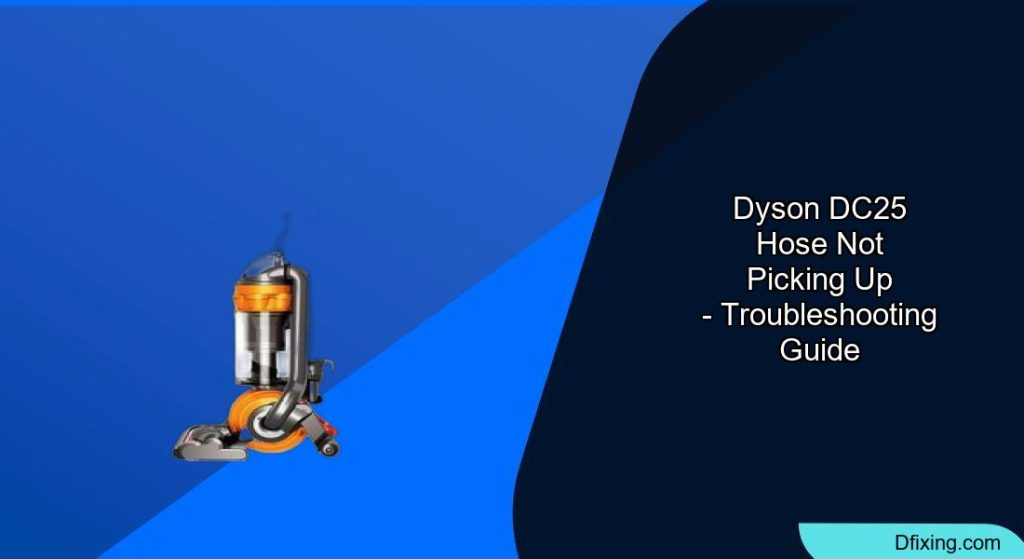The Dyson DC25 is a powerful vacuum cleaner known for its excellent suction capabilities. However, like any vacuum, it can develop issues over time that affect its performance. One common problem that many Dyson DC25 owners face is poor or no suction through the hose. This can be frustrating, especially when you’re in the middle of cleaning your home.
Affiliate disclosure: As an Amazon associate, We'll earn a commission for every successful order through our affiliate links in the article. However, you won’t be charged anything for this.
When your Dyson DC25 hose isn’t picking up properly, the issue typically stems from blockages, filter problems, or mechanical failures within the vacuum system. The good news is that many of these problems can be diagnosed and fixed at home without professional help. In this comprehensive guide, we’ll walk you through the common causes of suction problems in your Dyson DC25 and provide detailed troubleshooting steps to get your vacuum working efficiently again.
Common Causes of Dyson DC25 Suction Problems
When your Dyson DC25 vacuum cleaner fails to pick up dirt effectively, several issues might be at play. Identifying the root cause is the first step toward resolving the problem.
Clogged Filters
Dyson vacuums rely on multiple filters to trap dust and allergens. When these filters become clogged with dirt and debris, airflow is restricted, significantly reducing suction power. The DC25 has two main filters:
- Pre-motor filter: Located at the back of the vacuum
- Post-motor filter: Found in the ball mechanism
Both filters require regular cleaning to maintain optimal performance.
Blockages in the Hose System
Obstructions anywhere in the vacuum’s airflow path can cause suction problems. Common blockage points include:
- The main vacuum hose
- The wand connection
- The changeover valve (which directs suction between the floor head and hose)
- The small suction hose inside the machine
Dustbin Issues
A full or improperly sealed dustbin can restrict airflow and reduce suction power. Additionally, debris caught in the cyclone assembly can impede performance.
Mechanical Problems
More serious issues might include:
- Damaged brush bar or belt
- Faulty motor or fan
- Air leaks from loose connections
- Problems with the changeover valve mechanism
Initial Troubleshooting Steps
Before diving into more complex repairs, start with these basic troubleshooting steps to potentially resolve your suction issues quickly.
Empty and Clean the Dustbin
- Press the release button on the side of the vacuum to remove the dustbin
- Empty all contents into a trash bag
- Tap the sides gently to dislodge any stuck debris
- Rinse the dustbin with cold water if necessary
- Allow it to dry completely before reattaching
Important: Never reattach a wet dustbin to your Dyson as this could damage the electrical components.
Clean the Filters Thoroughly
Dirty filters are often the primary culprit behind suction problems. To clean them:
Pre-Motor Filter:
- Locate the handle at the back of the vacuum
- Pull it down to access the filter compartment
- Remove the pre-motor filter
- Rinse it under cool running water until the water runs clear
- Gently squeeze out excess water
- Allow it to air dry completely for at least 24 hours
Post-Motor Filter:
- Access the filter in the ball mechanism
- Tap it to remove loose dust
- For thorough cleaning, wash with warm water (no detergents)
- Let it dry completely for 24 hours before reinstalling
Additional Filters:
- Remove Filter A (canister filter) and Filter B (base filter)
- Wash both in water with mild detergent
- Rinse thoroughly and allow to dry completely
Pro Tip: Set a reminder to clean your filters every three months for optimal performance.
Sometimes, despite thorough cleaning, filters can become too worn or damaged to function effectively. If your filters are old or visibly damaged, consider replacing them to restore optimal suction.
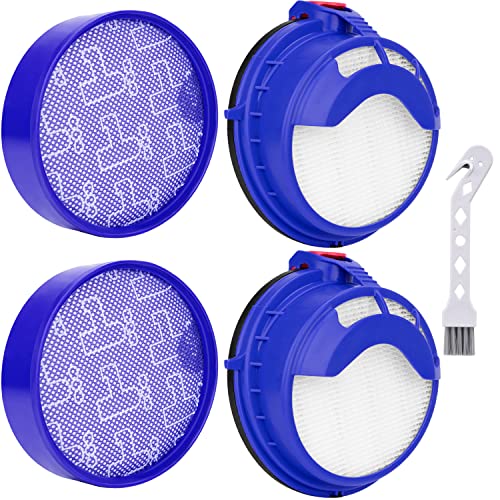
Premium 4-filter set with HEPA capture and cleaning brush
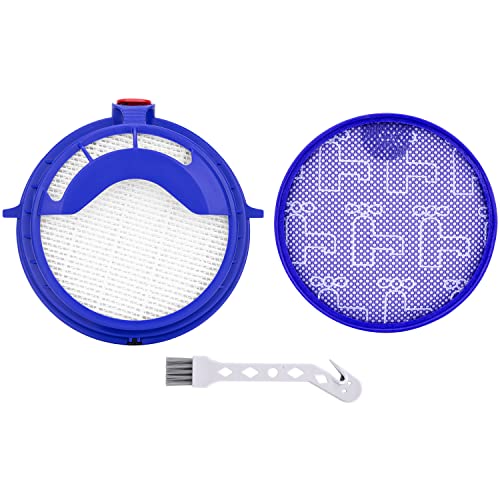
Complete replacement kit with high-efficiency filters
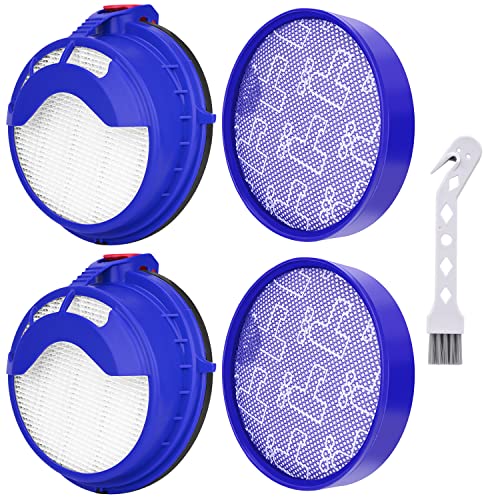
Durable 4-filter set with enhanced particle capture
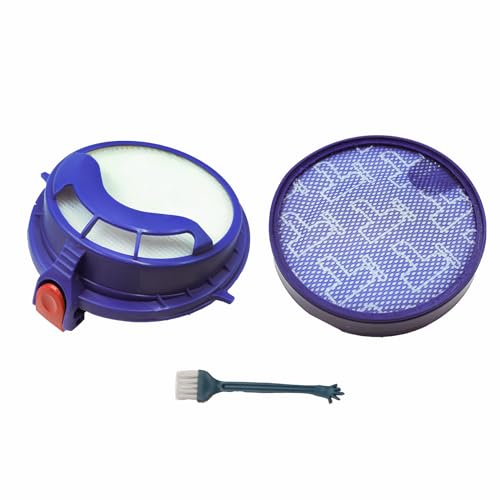
Cost-effective filter pair with performance benefits
Advanced Troubleshooting for Hose Suction Problems
If basic maintenance doesn’t resolve the suction issues, proceed with these more detailed troubleshooting steps.
Checking for Hose Blockages
- Detach the hose from both ends of the vacuum
- Hold it up to a light source to look for visible blockages
- Use a flashlight for better visibility
- Insert a long, thin object like a straightened coat hanger to probe for and remove obstructions
- Run water through the hose to flush out stubborn debris (ensure it’s completely dry before reattaching)
If your Dyson DC25 hose is damaged beyond repair or severely clogged, replacing it might be the best option to restore suction power.
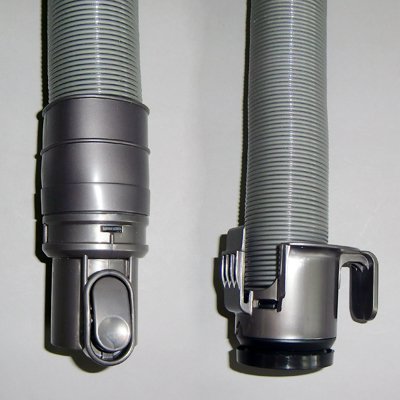
Official Dyson replacement with OEM quality
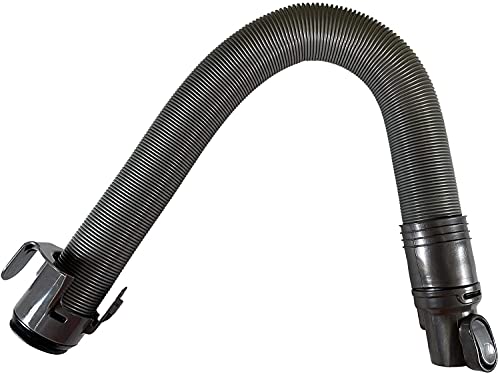
Enhanced suction with premium design

Affordable option with model compatibility
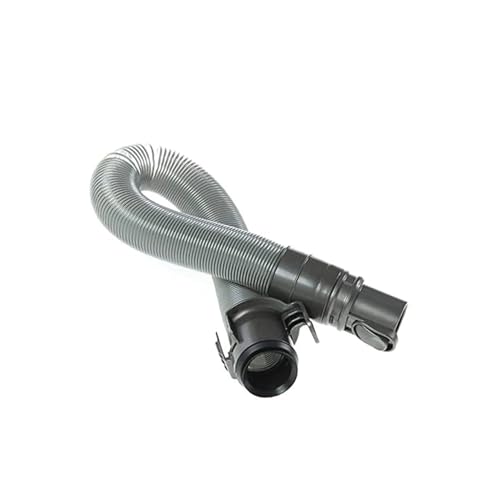
Flexible with strong suction performance
Inspecting the Changeover Valve
The changeover valve is a critical component that directs suction between the floor head and hose. Problems with this valve are a common cause of hose suction issues.
- Recline the machine to access components more easily
- Remove the ball cover and filter
- Locate the changeover valve (a large plastic tee-shaped part)
- Use needle-nose pliers or vice grips to carefully remove the valve
- Inspect for foreign objects or damage
- Common obstructions include small pieces of tubing, fabric, toys, or pens
- Remove any blockages and check the valve for proper movement
- Reassemble carefully
Examining the Small Suction Hose
A less obvious but common problem area is the small suction hose inside the machine:
- Locate the small hose with a red cap at the back of the machine
- Check for cracks, tears, or blockages
- Ensure it’s securely connected at both ends
- Clear any obstructions using a thin object or compressed air
- Verify there are no air leaks when the machine is running
Testing Suction at Different Points
To isolate where the suction problem occurs:
- Remove the floor head and test suction directly at the wand connection
- If suction is strong here but weak through the hose, the issue is likely in the hose system
- Test suction at the base unit without the wand attached
- This methodical approach helps pinpoint exactly where the problem lies
Troubleshooting Floor Head Issues
Sometimes what appears to be a hose suction problem is actually related to the floor head.
Brush Bar Problems
- Turn the vacuum upside down to inspect the brush bar
- Check for hair, string, or debris wrapped around the brush
- Use scissors to carefully cut away any tangled material
- Ensure the brush rotates freely
- If the brush bar is damaged, it may need replacement
If the brush bar is severely worn or damaged, replacing it can improve the floor head’s cleaning performance and overall suction.
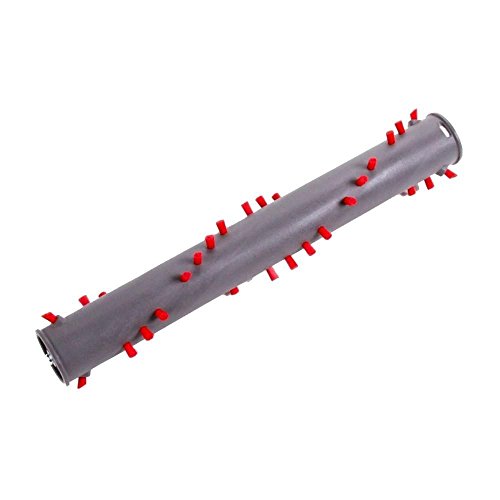
Official replacement with 30-day guarantee for DC25 vacuums
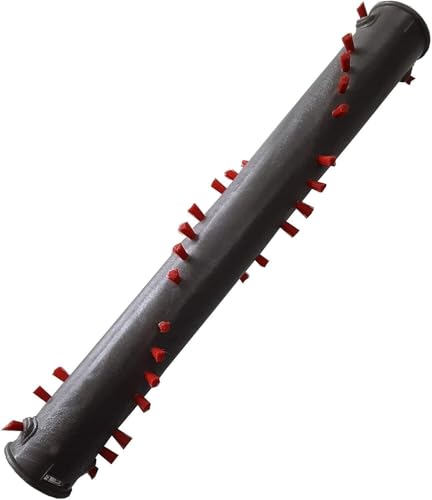
Direct OEM replacement with local store support and warranty
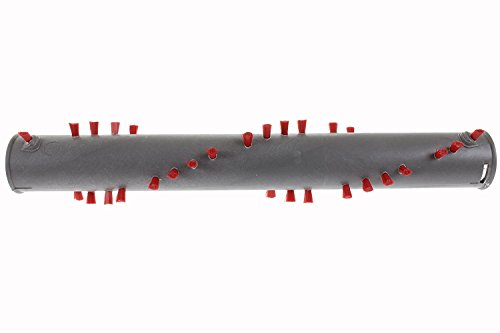
Affordable compatible option with deep cleaning performance
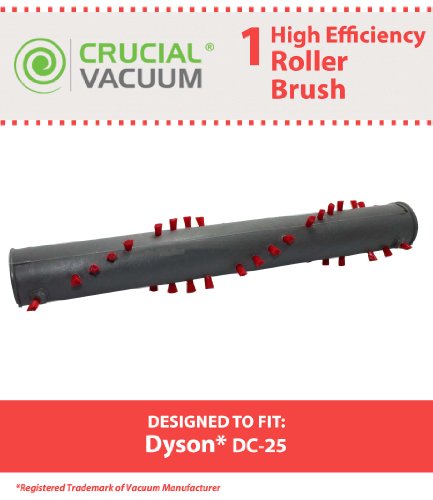
Performance-focused upgrade with precision-engineered bristles
Height Adjustment and Carpet Compatibility
The DC25 may struggle with certain carpet types:
- Very high-pile or ultra-plush carpets can create a seal that prevents proper airflow
- Rubber-backed carpets can stall the brush roll
- Try adjusting the height setting if your model has this feature
- For problematic carpets, consider using just the hose with appropriate attachments
Addressing Specific Technical Issues
Cyclone Assembly Problems
The cyclone assembly can accumulate debris that affects performance:
- Remove the dustbin
- Inspect the cyclone assembly for buildup
- Use a soft brush to clean between the cyclone fins
- Ensure the cyclone assembly is properly seated when reassembled
Checking for Air Leaks
Air leaks can significantly reduce suction power:
- Inspect all connection points for gaps or damage
- Check the integrity of the hose for small tears or cracks
- Ensure the dustbin is properly seated and sealed
- Verify that all clips and latches are secure
- Listen for unusual whistling sounds when the vacuum is running, which often indicate leaks
Motor and Fan Issues
If you’ve tried everything else, the problem might be with the motor or fan:
- Listen for unusual noises during operation
- Check if the vacuum is overheating and shutting off
- Inspect the fan blades for damage if accessible
- Motor or fan issues typically require professional repair or part replacement
Frequently Asked Questions (FAQ)
Why does my Dyson DC25 have strong suction at the wand but not through the hose?
This typically indicates a blockage in the hose itself or at the connection points. Detach the hose completely and check for obstructions at both ends. Also inspect the changeover valve, as it might not be properly directing airflow to the hose.
How often should I clean the filters on my Dyson DC25?
Dyson recommends cleaning both the pre-motor and post-motor filters at least every three months. However, if you vacuum frequently or have pets, you might need to clean them more often. Regular filter maintenance is crucial for maintaining proper suction.
My Dyson DC25 suddenly lost suction while vacuuming. What happened?
Sudden suction loss often indicates that something has been sucked up and caused a blockage. Check the hose, wand, and changeover valve for obstructions. Another possibility is that the dustbin is full and needs emptying. In some cases, the vacuum might have overheated and shut off automatically – allow it to cool for about an hour before trying again.
Can I replace the hose on my Dyson DC25 myself?
Yes, you can replace the hose yourself. Replacement hoses are available from Dyson directly or from third-party retailers. The process involves disconnecting the old hose at both ends and connecting the new one. Refer to your user manual for specific instructions or search for video tutorials online.
Why does my Dyson DC25 keep cutting out during use?
Frequent shutdowns are usually caused by overheating, which can result from blocked filters, obstructions in the airflow path, or a full dustbin. Clean all filters, check for blockages, and ensure the dustbin is empty. If the problem persists, there might be an issue with the motor that requires professional attention.
Conclusion
Suction problems with your Dyson DC25 hose can be frustrating, but in most cases, they can be resolved through proper maintenance and troubleshooting. Start with the basics: empty the dustbin, clean the filters, and check for obvious blockages. If these steps don’t work, proceed to more detailed examinations of the changeover valve, small suction hose, and other components.
Regular maintenance is key to preventing future issues. Clean your filters every three months, empty the dustbin after each use, and periodically check for blockages in the hose and wand. With proper care, your Dyson DC25 should provide powerful suction for years to come.
If you’ve tried all the troubleshooting steps in this guide and still experience suction problems, it might be time to contact Dyson customer support or take your vacuum to an authorized repair center. Sometimes, internal components may need professional attention or replacement to restore your vacuum’s performance to its original standard.

